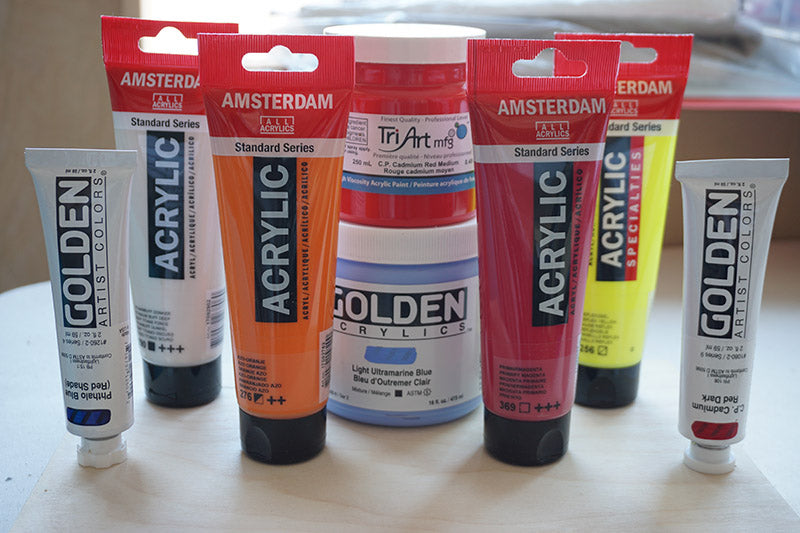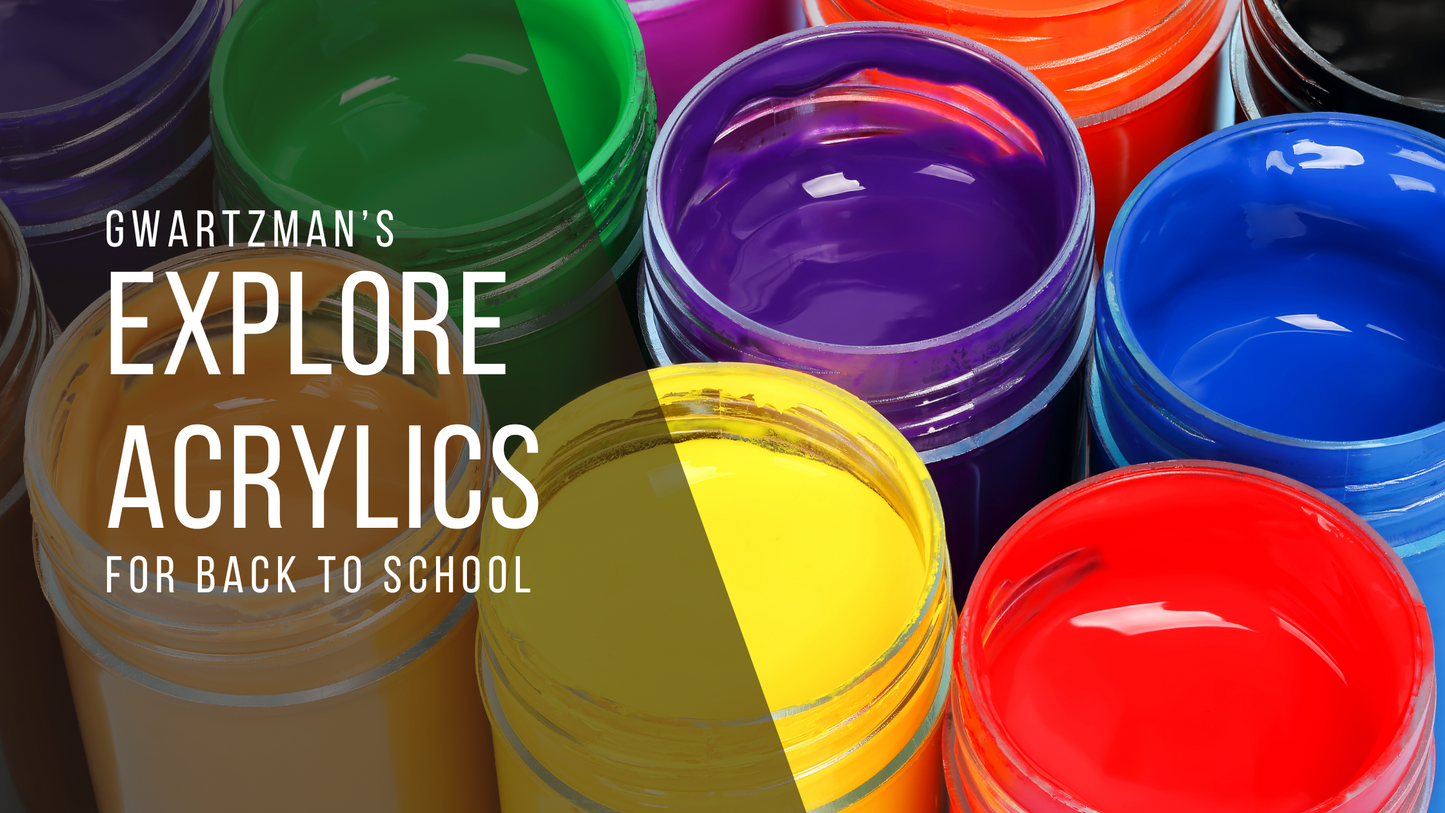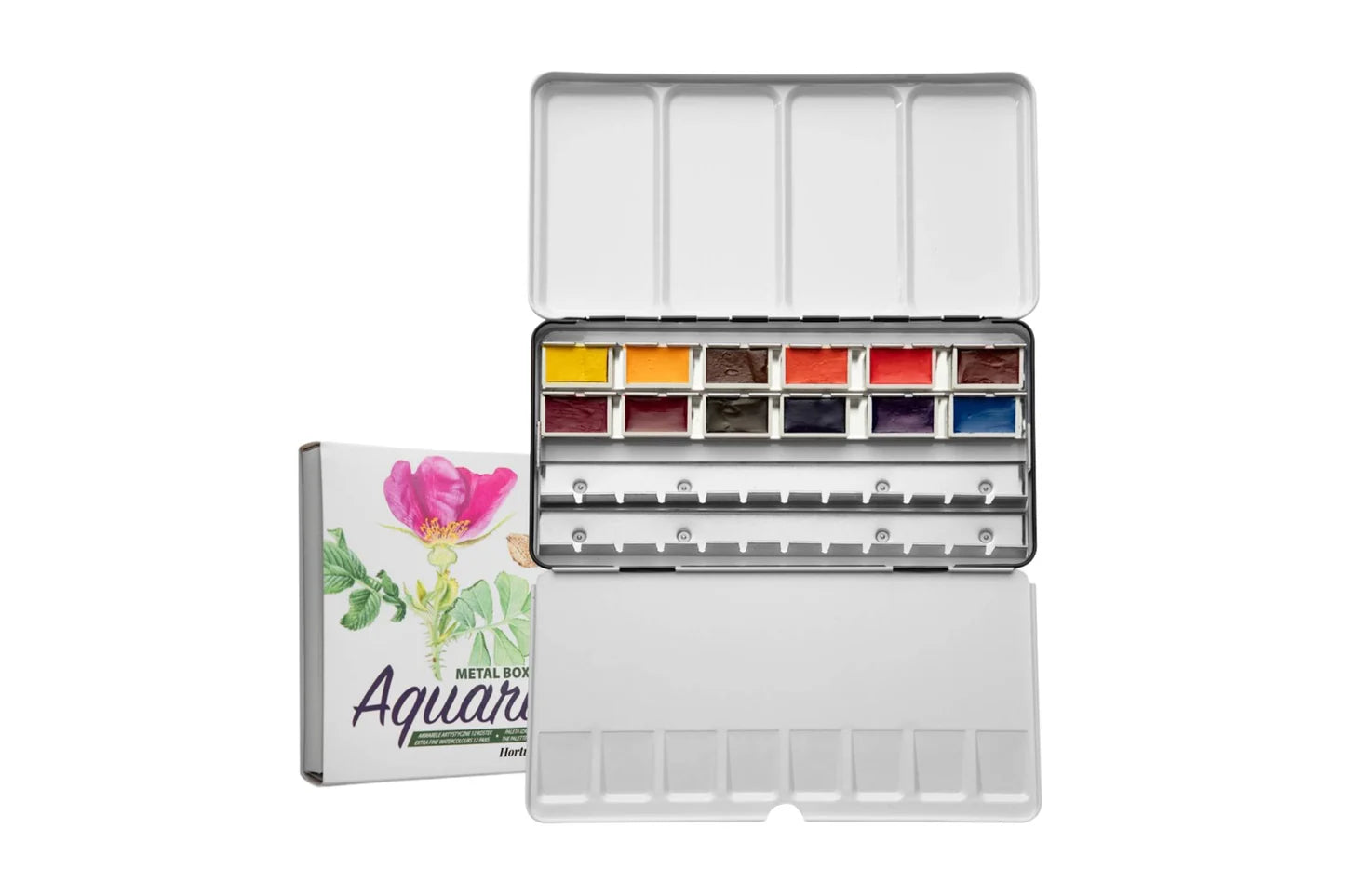
Buying paint when you’re unfamiliar with terms on the label can seem overwhelming and confusing, no matter if you’re buying in person or online.
Buying paint when you’re unfamiliar with terms on the label can seem overwhelming and confusing, no matter if you’re buying in person or online.
What’s a hue? Why do some brands of paint have a series number on it and why does that make them more expensive? Why does lightfastness matter? Is this paint opaque or transparent? And why does this tube have a health and safety warning label on it?

What is difference between these almost identical jars of Tri-Art red paint?
What are hues?
What does this mean when you see a tube labelled “Cadmium Red Hue'' vs “Cadmium Red”? Any tube labelled “hue” is an imitation of the real pigment. Now why would you want a fake version of a paint? Cadmium is expensive and dangerous to manufacture and the hue had been deemed by the paint manufacturer as an acceptable replacement in terms of colour.
While cadmium red hue and cadmium red might look similar in the tube, you’ll find that they act quite differently on the palette. They might vary in intensity, mass tone, hue and opacity. True cadmiums are very bright, opaque colours often used in final layers of paintings. The “hue” version of cadmium is bright in the tube, and on the palette, but you’ll notice a distinct difference in opacity.

Here on the left is the cadmium red hue, and on the right authentic cadmium red. You can see the hue is more orange in masstone than the authentic version, as well as more transparent.
Paint Series
Another thing you might notice on a tube of paint is a series number. When a paint brand has paints separated into series, they are priced from cheapest at series 1 and get progressively more expensive. However, just because a paint is series 1, doesn’t mean that it’s low quality paint. It means that the pigment in the paint is easier to acquire or manufacture than paints with a higher series number.

These paints from Golden have series numbers from 1-9. The higher the number, the harder and/or more expensive the pigment inside is to acquire. These labels also show transparency and lightfastness.
Paint Opacity and Lightfastness
There are various ways that paint manufacturers show the opacity of the paint inside the tube. Some brands, such as Amsterdam, have a square on the side of the tube. A black square denotes an opaque paint, a square with a diagonal line through it, and the bottom half is black means a semi transparent paint. A clear square means it will be transparent.

The black box on this label indicates the pain inside is opaque. Amsterdam rates their light fastness with plus signs. The +++ indicated high lightfastness, and this paint will not fade "in museum conditions" for at least 100 years

The half black square indicates that this paint is semi-transparent. The ++ indicates that the paint will resist fading for 25-100 years.

The clear square shows that the paint inside this tube is transparent.

Occasionally you will find tubes that have no rating. This is particularly common with fluorescent colours. These paints are made with dyes instead of pigments and the colors are fugitive, meaning they will start to fade very very quickly. It is best to keep these paints out of direct sunlight, and protected with a UV varnish or museum quality glass if you want to keep the colour from fading.
Other brands, such as Golden, have a streak of paint laid over diagonal black and white lines. This allows you to see the paint’s transparency over both light and dark backgrounds.
The label will also tell you how lightfast each paint is. This is useful information to know how your painting will look in the future, particularly if it will be displayed in a room with lots of light. Many artists' paints have excellent lightfastness. But there are some traditional pigments, such as authentic alizarin crimson have terrible lightfastness and fade quickly with time and exposure to the sun. Any paints that are fluorescent or phosphorescent will have poor lightfastness as well. Try to keep them out of direct sunlight or and if possible, protected with a UV varnish.
Health and Safety Warnings
And while you still might be mulling over your decision to buy cadmium red or cadmium red hue, there’s one more thing to consider. True cadmium paints are carcinogenic and will have a warning label on them. While they are generally fine to paint with, they could have ill effects on your health were you to accidentally inhale them. Cadmium, Cobalt, lead white, amongst others, should never be sprayed.

Pigment Colour Index Number
The final thing to take note of on the paint tube label is the Pigment Color Index Number on the side of the tube, it may help you reach a decision on buying that tube of paint. Let's take for example these tubs of Ultramarine blue and Light Ultramarine blue.

Both are beautiful colours, but consider what you really need.
Ultramarine blue is a single pigment (PB29), meaning you cannot mix this specific colour from other paints.

But Light Ultramarine Blue is labelled as a mixture.

Let's take a closer look.

Here on the side of the tub, we see that the ultramarine blue is mixed with PW6, which is titanium white, the most common white in use by painters. Should you buy Ultramarine blue light? Maybe, especially if you are intending to use a lot of it in your painting. But maybe not, if you only need small amounts, and can easily mix your own on the palette.
If you want to identify what pigments are used in your paints, check the manufactures website, or check your Pigment Index Number here.
We hope that answers any basic questions about ready paint labels! Please let us know down in the comments if we can clarify anything for you.









Comments
I am getting prepared to teach a class, and wanted to refresh my mind about color and color safety . I stumbled upon your website and how happy I am!! What a wealth of knowledge! Thank you so much!!
Very informative. Thank you for sharing.